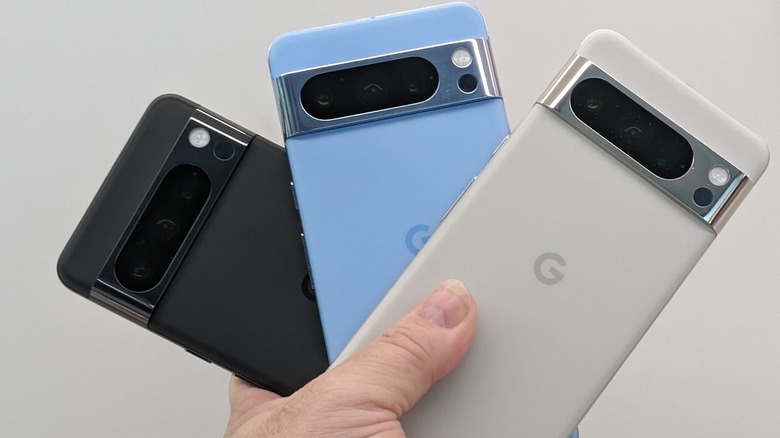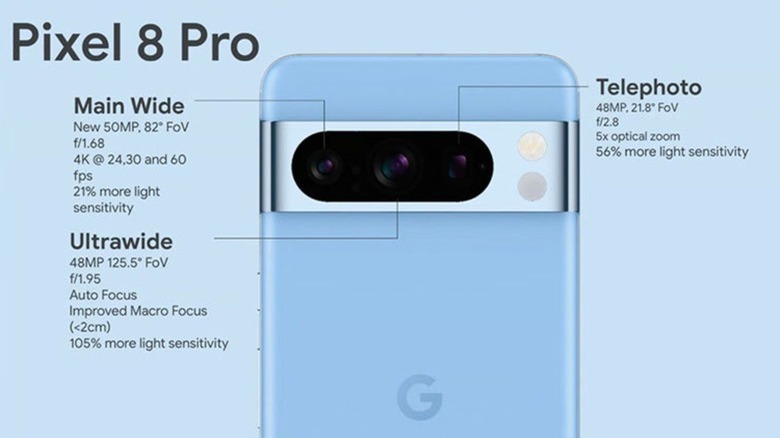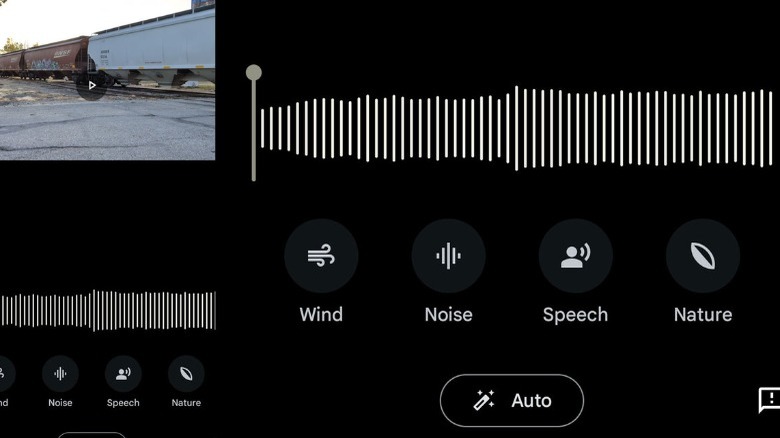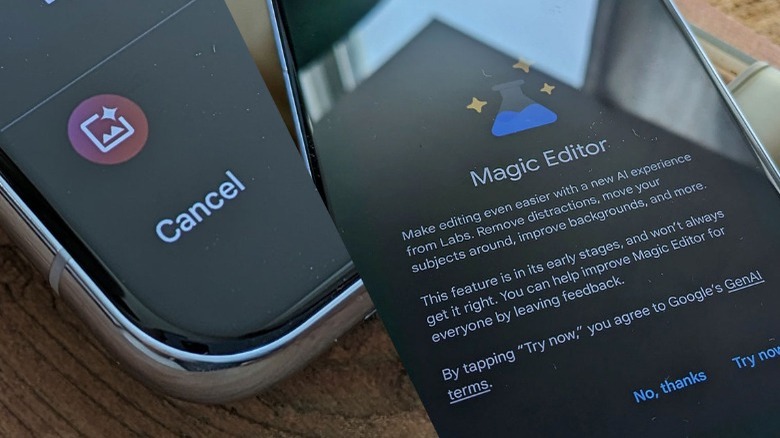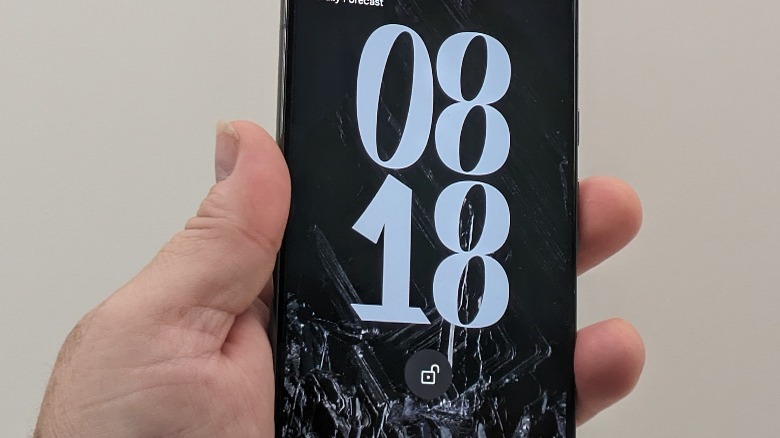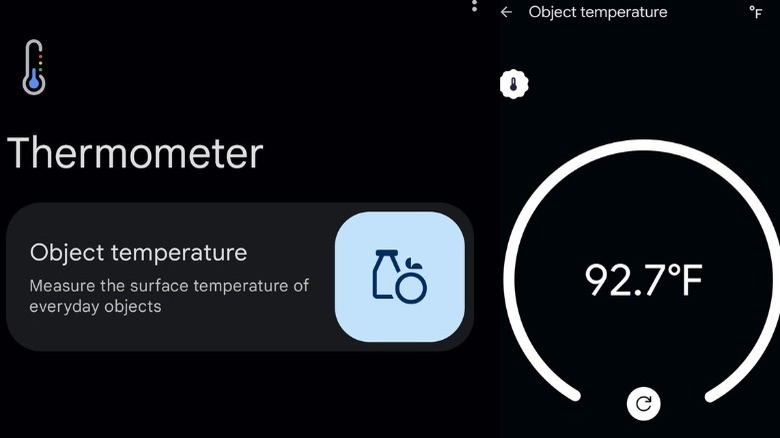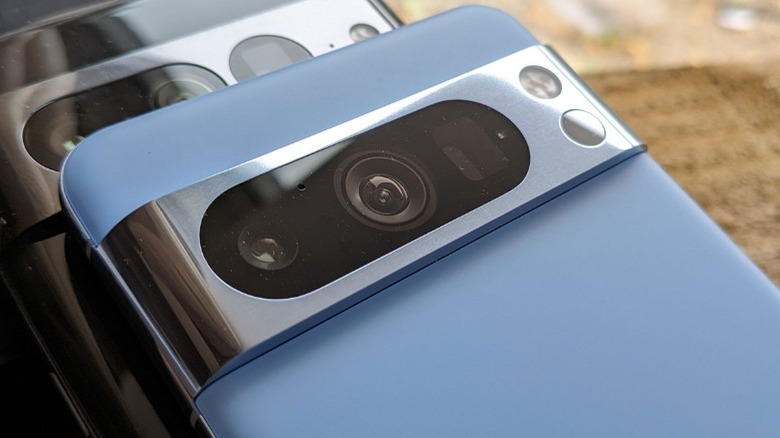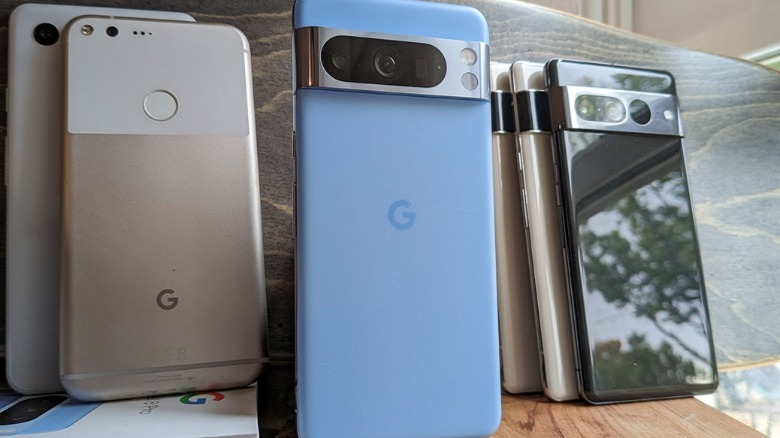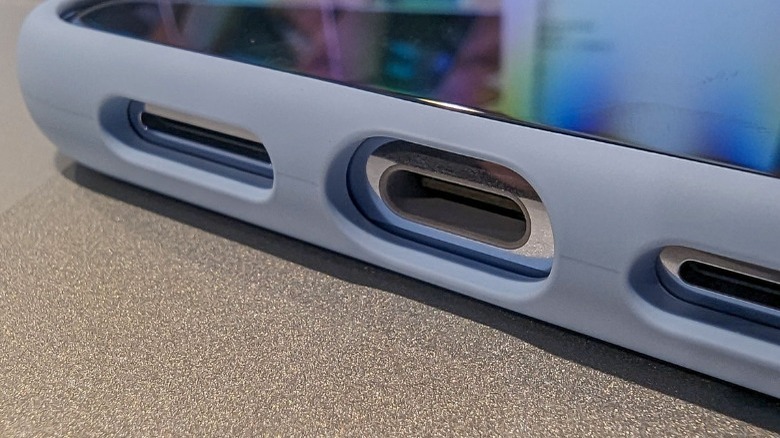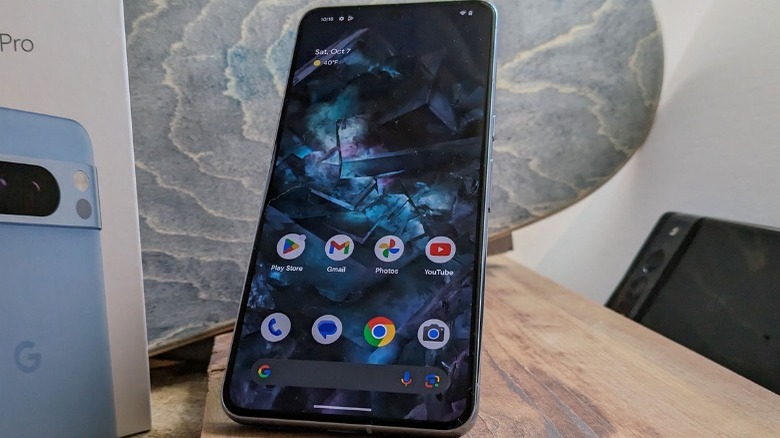Every Improvement Google Made In The Pixel 8 And Pixel 8 Pro
Google entered the smartphone market in 2010 with its Nexus brand, but switched to focus on higher-end devices that could directly compete with the likes of the iPhone and Samsung Galaxy in 2016. This marked the launch of the Pixel brand, a series of smartphones that has seen new models released each year. The range has since expanded to include laptops, tablets, and smartwatches, with the primary smartphone business rising in popularity over the last few years.
The most recent model is the Pixel 8 and Pixel 8 Pro. First announced in May 2023, the two Android devices hit store shelves on October 12 after a Made by Google launch event earlier in the month. Marketed as the most powerful and sophisticated smartphones ever created by Google, they include a raft of new features and improvements. In many ways, the advancements made in the Pixel 8 and Pixel 8 Pro could be the most substantial since the Pixel brand was first created.
Here's every improvement that Google has introduced with its new line of Pixel smartphones.
Camera upgrades for better pictures
One of the most essential features of any modern smartphone is its camera. With social media sites becoming increasingly popular and the growing desire among people to capture important moments, users demand quality cameras with their devices to get the best possible images and video. That has led to manufacturers such as Samsung and Apple working hard to keep improving the various cameras that are built into their smartphones.
Google is no different in that respect, and the Pixel 8 and Pixel 8 Pro carry a number of impressive upgrades that should allow users to take photographs and film videos at a higher image quality than was previously possible. This includes a 50-megapixel main camera, a 48-megapixel telephoto camera, and a 48-megapixel ultrawide camera, in addition to the improved selfie lens on the front that comes with autofocus on the Pixel 8 Pro. A new Macro Focus mode also allows users to take in-focus photographs from as close as 2 cm.
Meanwhile, the cameras can capture much more light than the Pixel 7 models, in some cases even doubling the amount of light the sensors receive. This allows the smartphones to produce images with more detail and more accurate color. It also takes better images and videos at night or in dark spaces than its predecessor. Google also promises its Real Tone technology should more accurately portray different skin tones, a common complaint about smartphones from non-white users.
The Pixel 8 Pro also gives users more flexibility when it comes to controlling how images look, as it allows more camera parameters to be changed. These include manual adjustment of the shutter speed and ISO setting to get exactly the shots you want.
Audio Magic Eraser
The Magic Eraser tool was one of the most celebrated features when it was announced for Pixel users. Using artificial intelligence, photographers could quickly and easily remove unwanted objects or people from photographs with just a few taps. It's an ideal feature for those who might have grabbed a great image without realizing that somebody was photobombing or an annoying item was in the background, as they could be wiped from the final photograph with the tool.
A similar technology is now coming to videos in the form of the Audio Magic Eraser. This time, though, the feature doesn't remove unwanted visual components but rather sounds from videos. The end result is that if there is a noise you don't want to hear in a video, the Pixel 8 and Pixel 8 Pro can help solve that problem. After a video has been recorded, the Audio Magic Eraser can isolate various noises and then remove them from the footage, leaving the other sounds untouched.
Demos of the Audio Magic Eraser at work have demonstrated that it is capable of working in a variety of different settings. At the beach, it can remove the noise of waves crashing against the shore or isolate a police siren so that the audio of a musical instrument is not drowned out. Of course, the feature isn't a perfect solution and can run into problems — like the Magic Eraser users are already familiar with — but it usually functions as intended and is an innovative inclusion.
An improved Magic Eraser
In addition to the Audio Magic Eraser, Google has also made the older Magic Eraser for images far more useful. Much of that is because the Pixel 8 and Pixel 8 Pro run Google's foundation models on the device rather than through the cloud. Google Senior Vice President Rick Osterloh says the "Pixel 8 Pro can run generative AI with up to 150 times more computations than the largest ML model on Pixel 7." That means it can utilize more advanced machine learning and artificial intelligence technology to improve features such as Magic Eraser.
What that means for Magic Eraser is that it is now smarter and more effective, especially when it comes to unblurring photographs or removing unwanted objects and people. Previously, Magic Eraser worked best when erasing parts of an image that were small or simple, with larger and more complex items causing problems as they were more difficult to blend with the rest of the picture. This can leave unsightly marks and visual artefacts on images.
This problem is no longer a major headache with the newly improved version. Working in a similar way to Photoshop's Generative Fill, the smartphone creates new pixels to replace what has been removed, using artificial intelligence to predict what should be in the image. Osterloh explained further, "Instead of blending the surrounding pixels, the improved Magic Eraser generates completely new pixels to fill in the places left behind by cars, people, or anything else you don't want in your shot."
Improved brightness
Brightness is an important feature on smartphones, so much so that it is often given prime real estate on menus so that it can be adjusted. Over the last few years, manufacturers have been increasing the peak brightness of devices. In fact, the number of smartphone models with brightness levels over 900 nits almost tripled from 2021 to 2022, establishing a clear pattern of screens becoming brighter.
That shouldn't be a huge surprise given that smartphones are increasingly being used to consume content. It is now commonplace for users to watch television series, films, and other videos on their phones, with higher brightness levels helping to make colors more vivid and allowing people to see the screen better. This is especially important when outside, where the glare of the sun can make viewing the screen difficult.
Thanks to what Google calls an Actua display, the Pixel 8 and Pixel 8 Pro have much higher peak brightness levels than previous devices. The base model can reach up to 2,000 nits when in high brightness, while the more advanced Pixel 8 Pro has a peak brightness of 2,400 nits. Out of direct sunlight and with HDR enabled, the two devices have 1,400 and 1,600 nits respectively, more than the Samsung Galaxy S23 and equal to the iPhone 15. In benchmark tests by DXOMARK, the Pixel 8 series has the best overall scores.
The Pixel 8 Pro comes with a temperature sensor
Perhaps the most surprising announcement in the Pixel 8 series introduction was that the Pixel 8 Pro comes equipped with a temperature sensor. Embedded in the camera array on the back of the phone, this sensor can be used to determine the temperature of various objects in a simple process. The new feature is only available on the more expensive premium device and is fairly unique in the world of smartphones.
To use the temperature sensor, users simply need to hold the smartphone relatively close to the target, with a suggested distance of 5cm, and then hit the required button for the phone to determine a temperature in both Celsius and Fahrenheit. It's also possible to get more accurate readings by selecting from a range of options regarding the type of material being measured, from metals to plastics and even liquids.
There are some obvious applications for the thermometer, including being able to quickly test how hot food is or measure if a bath is warm enough for you to jump in. Google has also submitted an application to the FDA in order to get approval for the Thermometer app to be used to take the temperature of a person and save that information to other apps (such as Fitbit). Tests carried out by Beebom suggest that the temperature sensor is accurate and reliable, though, so users should be able to use the Thermometer app with confidence.
A host of AI-driven camera tools
The new Pixel smartphones come with a range of AI-driven camera tools. An obvious example of this is Zoom Enhance, a new tool that will arrive in the coming months that uses generative AI to "intelligently fill in the gaps between pixels and predict fine details." This means that when zooming in on photographs, the image will no longer be blurry and lose detail. Another inclusion is Video Boost, a tool that automatically uploads footage captured on a Pixel 8 phone to Google servers for processing, reducing noise, and sharpening frames.
Best Take is among the stranger and more useful additions to the Pixel 8 series. The feature has been designed to get around the perennial problem that comes with taking group photos, where someone will inevitably be looking the wrong way or pulling a strange face. By combining multiple similar shots taken at the same time, Best Take gives users the opportunity to blend together these images by choosing different facial expressions from an options menu to get the perfect picture where everyone is smiling and looking at the camera.
The Pixel 8 and Pixel 8 Pro also come with Magic Editor, a more expansive way to edit photographs on your smartphone without the need for specialist software or skills. Working in a similar way to Magic Eraser, it's possible to tap or circle objects that can then be moved and resized. Google Photos will even suggest edits, such as changing the skyline or lighting in a photograph to make the background more appealing.
Seven years of system updates
One of the most important aspects of any new smartphone is how long it will be supported by the manufacturer. After all, these kinds of devices are incredibly expensive and, while many people upgrade every couple of years, a lot of users will want their smartphone to last. How long a smartphone remains viable often has little to do with the actual hardware. Instead, the firmware is more critical, with software and security updates determining when support officially stops. Once a device no longer receives these important patches, it can quickly lose access to certain apps and features, in addition to becoming vulnerable to exploits.
Google's Pixel range has typically lagged behind other major manufacturers when it comes to long-term support. The Pixel 7 only promised three years of Android updates and five years of security patches. That doesn't compare favorably with Samsung's Galaxy S23, which guarantees four years of OS upgrades, and Apple's various iPhone models that typically come with more than five years of OS and security updates. Theoretically, this meant that Pixel users would have to replace their smartphones more frequently to stay up to date.
With the Pixel 8 and Pixel 8 Pro, Google is significantly improving its support. According to the company, the new smartphones will receive seven years of updates, including "Android OS upgrades, security updates, and regular Feature Drops." The company argues that by supporting the latest models until 2030, customers get better value for their money and the devices become more sustainable and environmentally friendly.
Quality-of-life improvements across the board
On top of the headline upgrades, Google has made a series of improvements to other areas that should increase the overall quality of life of the Pixel 8 and Pixel 8 Pro. Unlike previous generations, the Pixel 8 Pro supports larger storage options. Customers can access the basic 128GB model, or upgrade to 256GB, 512GB, or even 1TB. That's double the maximum capacity of the Pixel 7 Pro, and a useful option given that the new phone is capable of recording 4K video at 60 FPS. Unfortunately, the 1TB version is exclusive to the United States, although the entire Pixel 8 series now features 12GB of RAM as standard worldwide.
The Pixel 8 also supports refresh rates of 120HZ, while the Pixel 8 Pro has adaptive refresh rates that can go as low as 1Hz. More useful for those who are constantly on the move are screen context and Read Aloud & Translate. The first of these can provide brief summaries of the content on your screen, while the second feature can read web pages out loud or translate the text to other languages.
Both devices also support a new Voice Typing feature, giving users the opportunity to dictate text without any physical inputs. The tool, which can also be used to edit pre-existing text, will intelligently leave out interruptions and pauses to give you time to think before deciding what to say. Impressively, all of this is done natively on the device, rather than being processed using cloud servers. Another feature, known as Guided Frame, helps visually impaired users take photographs. By recognizing faces and objects, it can give audio cues and haptic feedback to guide where the camera should point for the best picture.
The upgraded Tensor G3 chip
Although the Pixel line has been growing in popularity, there is a specific area where it has attracted criticism, and that is the chip powering the smartphone. The previous Tensor G2 lagged behind its competitors in the form of the Qualcomm Snapdragon 8 range and Apple's own A16 Bionic. That was largely due to the fact that the chip uses outdated components and utilizes machine learning. For its Pixel 8 series, Google has developed a new chip that is far more powerful and capable.
Don't get us wrong, the Tensor G3 still isn't top-notch when it comes to peak performance, although it does bridge the gap somewhat. However, it does seemingly operate at lower temperatures, which should help some of the overheating issues with previous Pixel smartphones. But Google doesn't want its chips to focus on raw power. Instead, the Tensor G3 is an evolution of the company's approach, with the chip continuing to "push the boundaries of on-device machine learning, bringing the latest in Google AI research directly to our newest phones" (via Google).
According to Google, the Tensor G3 is capable of running double the amount of machine learning models directly on the phone than the first iteration of the chip. This allows for on-device generative AI to work in a number of tools and features that were previously incompatible.
